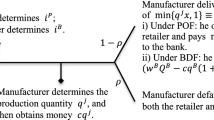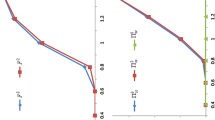Abstract
The manufacturer who is a supplier of trade credit may face non-payment risk from customers and a capital shortage problem simultaneously. Trade credit insurance, as one of the most important risk management tools, has been widely used in companies’ daily operation. In this study, the manufacturer who allows customers to delay payment for goods already delivered purchases trade credit insurance to transfer and reduce non-payment risk and borrows money from a bank to accommodate the capital constraint problem. The Stackelberg game and loss-averse theory are used to establish a newsboy model including trade credit insurance, and the optimal insurance coverage and total sales of the manufacturer are thereby investigated. Subsequently, the interest rate decision of the bank under different risk-averse situations is also characterized. We find that the interest rate set by a loss-averse bank is equal to or greater than that given by a risk-neutral bank. The use of trade credit insurance can help the manufacturer expand sales and dramatically reduce its default risk. Both the bank and the manufacturer are better off due to the use of trade credit insurance, but contrary to what one might expect, the bank prefers giving a higher interest rate to the manufacturer when the premium rate is in a reasonable region, which indicates that the manufacturer cannot use the insurance to negotiate better financing terms.








Similar content being viewed by others
References
Abraham, F., & Dewit, G. (2000). Export promotion via official export insurance. Open Economies Review, 11, 5–26.
Almeida, H., Campello, M., & Weisbach, M. S. (2011). Corporate financial and investment policies when future financing is not frictionless. Journal of Corporate Finance, 17(3), 675–693.
Brown, W., & Haegler, U. (2004). Financing constraints and inventories. European Economic Review, 48(5), 1091–1123.
Buzacott, J. A., & Zhang, R. Q. (2004). Inventory management with asset-based financing. Management Science, 50(9), 1274–1292.
Cai, G., Chen, X., Xiao, Z. (2014). The roles of bank and trade credits: Theoretical analysis and empirical evidence. Productions and Operations Management, 23(4), 583–598.
Caldentey, R., & Haugh, M. B. (2009). Supply contracts with financial hedging. Operations Research, 57(1), 47–65.
Camerer, C. F. (2001). Prospect theory in the wild: Evidence from the field. In D. Kahneman & A. Tversky (Eds.), Choices, values, and frames (pp. 288–300). Cambridge: Cambridge University Press.
Chen, X., & Cai, G. (2011). Joint logistics and financial services by a 3PL firm. European Journal of Operational Research, 214(3), 579–587.
Chen, X., & Wang, A. (2012). Trade credit contract with limited liability in the supply chain with budget constraints. Annals of Operations Research, 196(1), 153–165.
Dada, M., & Hu, Q. (2008). Financing newsvendor inventory. Operations Research Letters, 36(5), 569–573.
Dewit, G. (2001). Intervention in risky export markets: Insurance, strategic action or aid? European Journal of Political Economy, 17, 575–592.
Eeckhoudt, L., & Loubergé, H. (1988). Export credit insurance: Comment. The Journal of Risk and Insurance, 55(4), 742–747.
Egger, P., & Url, T. (2006). Public export credit guarantees and foreign trade structure: Evidence from Austria. The World Economy, 29(4), 399–418.
Ford, J. L., Mpuku, H. C., & Pattanaik, P. K. (1996). Revenue risks, insurance, and the behavior of competitive firms. Journal of Economics, 64(3), 233–246.
Funatsu, H. (1986). Export credit insurance. The Journal of Risk and Insurance, 53(4), 679–692.
Jensen, M. (1986). Agency cost of free cash flow, corporate finance, and takeovers. Corporate finance, and takeovers. American Economic Review, 76(2), 323.
Jing, B., Chen, X., & Cai, G. (2013). Equilibrium financing in a distribution channel with capital constraint. Production and Operations Management, 21(6), 1090–1101.
Jones, P. M. (2010). Trade credit insurance. Primer Series on Insurance, 15, Washington, DC: World Bank.
Kouvelis, P., & Zhao, W. (2012). Financing the newsvendor: Supplier vs. bank, and the structure of optimal trade credit contracts. Operations Research, 60(3), 566–580.
Lai, V. S., & Soumaré, I. (2010). Credit insurance and investment: A contingent claims analysis approach. International Review of Financial Analysis, 19(2), 98–107.
Mauer, D. C., & Triantis, A. J. (1994). Interactions of corporate financing and investment decisions: A dynamic framework. The Journal of Finance, 49(4), 1253–1277.
Modigliani, F., & Miller, M. H. (1958). The cost of capital, corporation finance and the theory of investment. The American Economic Review, 48(3), 261–297.
Myers, S. C. (1977). Determinants of corporate borrowing. Journal of Financial Economics, 5(2), 147–175.
Rabin, M. (1998). Psychology and economics. Journal of Economic Literature, 36(1), 11–46.
Rienstra-Munnicha, P., & Turvey, C. G. (2002). The relationship between exports, credit risk and credit guarantees. Canadian Journal of Agricultural Economics, 50, 281–296.
Robichek, A. A., & Horne, J. C. (1967). Abandonment value and capital budgeting. The Journal of Finance, 22(4), 577–589.
Schweitzer, M. E., & Cachon, G. P. (2000). Decision bias in the newsvendor problem with a known demand distribution: Experimental evidence. Management Science, 46(3), 404–420.
Stenbacka, R., & Tombak, M. (2002). Investment, capital structure, and complementarities between debt and new equity. Management Science, 48(2), 257–272.
Su, J., & Sun, Y. (2011). Informal finance, trade credit and private firm performance. Nankai Business Review International, 2(4), 383–400.
Wang, C., & Webster, S. (2009). The loss-averse newsvendor problem. Omega, 37(1), 93–105.
Wong, K. P. (2000). Insurance and the behavior of competitive firms under revenue risks: A note. Journal of Economics, 71(3), 305–314.
Xu, X., Birge, J.R. (2004). Joint production and financing decisions: Modeling and analysis. Working Paper.
Zammit, B., Ross, D. G., & Wood, D. (2009). Perceptions of export credit insurance value: Australian evidence. Asia-Pacific Journal of Business Administration, 1(2), 109–118.
Acknowledgments
This research was supported in part by the MOE Project of Key Research Institute of Humanities and Social Sciences at Universities (12JJD630004), National Natural Science Foundation of China (NSFC), Research Fund Nos 71372100 and 91024002, and the Research Grants Council of Hong Kong under GRF Project No. 410211.
Author information
Authors and Affiliations
Corresponding author
Appendix
Appendix
Proof of Theorem 1
The decision problem (1) can be rewritten as
Differentiating \(G(y,Q),\,g_1 (Q,y)\) and \(g_2 (Q,y)\) with respect to \(y\) and \(Q\), respectively, yields
\(\gamma ^{*}_1 \) and \(\gamma ^{*}_2 \) are Lagrange multipliers. \((Q^{*},y^{*})\) is K-T point and then Kuhn—Tucker conditions are given by
To solve these equations, we investigate several cases:
Case 1: \(\gamma _1 ^{*}\ne 0,\,\gamma _2 ^{*}\ne 0\). \(y^{*}=0\). \(Q^{*}=0\). No solution.
Case 2: \(\gamma _1 ^{*}\ne 0,\,\gamma _2 ^{*}=0\). \(y^{*}=0,\,Q^{*}=\frac{p(1-E(\alpha ))}{2c(1+r)}\), but \(\gamma _1 ^{*}=h-1<0\), so it is not K-T point.
Case 3: \(\gamma _1 ^{*}=0,\,\gamma _2 ^{*}\ne 0\). \(y^{*}=pQ^{*},\,Q^{*}=\frac{p(1-h)}{2c(1+r)}\), but \(\gamma _2 ^{*}=-h<0\), so it is not K-T point.
Case 4: \(\gamma _1 ^{*}=0,\,\gamma _2 ^{*}=0\). \((Q^{*},y^{*})\) satisfies the following equations:
Since \(\frac{\partial ^{2}G}{\partial y^{2}}=f\left( \frac{y}{pQ}\right) \frac{1}{pQ},\,\frac{\partial ^{2}G}{\partial Q^{2}}=2c(1+r)+f\left( \frac{y}{pQ}\right) \frac{y^{2}}{pQ^{3}}\),
Hesse matrix is
which is a positive matrix. Thus the objective is a convex function and the two constraints are linear functions so this is a convex programming. The optimal amount of the credit sales and optimal insurance coverage exist, given by
and \(2cQ^{*}(1+r)+p\int _{\frac{y^{*}}{pQ^{*}}}^1 {xf(x)dx} -p=0\).
Let \(\frac{y^{*}}{pQ^{*}}=\phi ^{*}\), then \(p\phi ^{*}F(\phi ^{*})-2cQ^{*}(1+r)+p\int _{\phi ^{*}}^1 {F(x)dx} =0\),
i.e., \(Q^{*}=\frac{p(1-h)\phi ^{*}+p\int _{\phi ^{*}}^1 {F(x)dx} }{2c(1+r)}\). And \(y^{*}=\phi ^{*}pQ^{*}\), where \(\phi ^{*}=F^{-1}(1-h)\).\(\square \)
Proof of Lemma 1
Differentiating \(Q^{*}=\frac{p(1-h)\phi ^{*}+p\int \nolimits _{\phi ^{*}}^1 {F(x)dx} }{2c(1+r)}\) with respect to \(h\) yields \(\frac{\partial Q^{*}}{\partial h}=\frac{p(1-h)\frac{\partial \phi ^{*}}{\partial h}-p\phi ^{*}-pF(\phi ^{*})\frac{\partial \phi ^{*}}{\partial h}}{2c(1+r)}\).
Since \(F(\phi ^{*})=1-h,\,\frac{\partial Q^{*}}{\partial h}=\frac{-p\phi ^{*}}{2c(1+r)}<0\), i.e., the amount of the credit sales decreases as the premium rate increases.
Differentiating \(F(\phi ^{*})=1-h\) with respect to \(h\), we have
Since \(\frac{\partial Q^{*}}{\partial h}<0\), we have \(\frac{\partial y^{*}}{\partial h}<0\), i.e., the insurance coverage is a decreasing function of the premium rate.\(\square \)
Proof of Theorem 2
When the manufacturer does not purchase the trade credit insurance, the objective function is \(E\pi _s (Q,0)=pQ\int _0^1 {F\hbox {(x)}dx} -B(1+r)-\eta \).
Differentiating \(E\pi _s (Q,0)\)with respect to \(Q\), we obtain
Furthermore, we have
\(E\pi _s (Q,0)\) is a strictly concave function in \(Q\) and the optimal amount of the credit sales is existent and unique. Let \(Q_0 ^{*}\) be the solution to \(\frac{d\pi _s (Q,0)}{dQ}=0\), then \(Q_0 ^{*}=\frac{p(1-E(\alpha ))}{2c(1+r)}\).\(\square \)
Proof of Lemma 2
For \(Q^{*}=\frac{p(1-h)\phi ^{*}+p\int _{\phi ^{*}}^{1} {F(x)dx} }{2c(1+r)}\) and \(F(\phi ^{*})=1-h\), we have \(Q^{*}=\frac{p(1-\int _{\phi ^{*}}^{1} {xf(x)dx} )}{2c(1+r)}\). Since \(E(\alpha )>\int _{\phi ^{*}}^{1} {xf(x)dx} \), we get \(Q_0 ^{*}<Q^{*}\).\(\square \)
Proof of Theorem 3
Since \(F\left( \frac{y^{*}}{pQ^{*}}\right) =1-h\), and \(\frac{y^{*}}{Q^{*}}F\left( \frac{y^{*}}{pQ^{*}}\right) -2cQ^{*}(1+r)+p\int _{\frac{y^{*}}{pQ^{*}}}^{1} {F(x)dx} =0\), we can get
Case 1: The non-risk operation, i.e., \(y^{*}\ge 2B(Q^{*})\) or \(B(Q^{*})<y^{*}<2B(Q^{*})\) and \(r\le \frac{y^{*}}{B(Q^{*})}-1\).
The expected profit of the bank is \(E\pi _b (r)=B(Q^{*})r\).
Differentiating \(E\pi _b (r)\) with respect to \(r\), we have
Furthermore, we obtain
So the expected profit of the bank is a strictly concave function of \(r\). The optimal interest rate is existent and unique. Let \(r^{*}\) satisfy \(\frac{dE\pi _b (r)}{dr}=0\), then we have \(r^{*}=\frac{B(Q^{*})}{cQ^{^{*}{2}}+\eta }\). If in the case of \(B(Q^{*})<y^{*}<2B(Q^{*})\) and \(r\in \left[ {0,\frac{y^{*}}{B(Q^{*})}-1} \right] \), then the optimal interest rate is \(\min \left\{ {\frac{y^{*}}{B(Q^{*})}-1,\frac{B(Q^{*})}{cQ^{^{*}{2}}+\eta }}\right\} \).
Case 2: The risk operation, i.e.,\(y^{*}<B(Q^{*})\) or \(B(Q^{*})<y^{*}<2B(Q^{*})\) and \(r>\frac{y^{*}}{B(Q^{*})}-1\).
The expected profit of the bank is \(E\pi _b (r)=y^{*}-B+pQ^{*}\int _z^1 {F(x)dx} \), where \(z=\frac{pQ^{*}+y^{*}-B(Q^{*})(1+r)}{pQ^{*}}\).
Differentiating \(E\pi _b (r)\) with respect to \(r\), we have
and then we obtain
Because \(\frac{d^{{2}}E\pi _b (r)}{dr^{{2}}}<0\), the expected profit of the bank is a strictly concave function of \(r\). The optimal interest rate is existent and unique. Let \(r^{**}\)satisfy \(\frac{dE\pi _b (r)}{dr}=0\), so we have \(\frac{2cQ^{^{*}{2}}-y^{*}}{1+r^{**}}-\frac{pQ^{*}}{{1}+r^{**}}\int _z^1 {F(x)dx} -2\eta F(z)=0\).
If \(B(Q^{*})<y^{*}<2B(Q^{*})\)and\(r>\frac{y^{*}}{B(Q^{*})}-1\), then the optimal interest rate is \(\max \left\{ {\frac{y^{*}}{B(Q^{*})}-1,r^{**}} \right\} \) \(\square \)
Proof of Theorem 4
Differentiating \(EU(\pi _b )\) with respect to \(r\) yields
Let \(r^{*}\) satisfies \(\frac{\partial EU(\pi _b )}{\partial r}=0\), then
Furthermore, we obtain
and
Since \(z_0 >z\), we get \(F(z_0 )>F(z)\).
So \(\lambda -F(z)+(1-\lambda )F(z_0 )=\lambda \bar{{F}}(z_0 )+F(z_0 )-F(z)>0\).
We also know \(\lambda \ge 1\), then\(\frac{d^{2}EU(\pi _b )}{dr^{2}}(1+r)^{2}\left| {_{r=r^{*}} } \right. <0\) and the sufficient condition is satisfied. The optimal interest rate \(r^{*}\)satisfies the following equation:
\(\square \)
Rights and permissions
About this article
Cite this article
Li, Y., Zhen, X. & Cai, X. Trade credit insurance, capital constraint, and the behavior of manufacturers and banks. Ann Oper Res 240, 395–414 (2016). https://doi.org/10.1007/s10479-014-1602-x
Published:
Issue Date:
DOI: https://doi.org/10.1007/s10479-014-1602-x




